Zoopraxiscope or zoogyroscope 1879 - precursors of film and movie
The Zoopraxiscope, invented by Eadweard Muybridge in 1879, is often referred to as one of the earliest precursors of the film and movie industry. This device was a forerunner to modern motion pictures and was the first invention that allowed the creation of moving images. It was a revolution in the field of animation and cinema, paving the way for the modern film industry.
Eadweard Muybridge was a British-American photographer and inventor who was fascinated by the study of motion. He was intrigued by the motion of animals and human beings and wanted to understand how they moved. In 1872, he was commissioned by Leland Stanford, a wealthy businessman and horse racing enthusiast, to prove that a horse had all four feet off the ground when it ran.
To do this, Muybridge used multiple cameras and set them up in a row to take sequential photographs of a horse running. He then used a Zoopraxiscope to project the images and create a moving image of the horse running.
The Zoopraxiscope was a simple device that used a spinning disc with evenly spaced slots. When the disc was rotated, a sequence of static images was projected through the slots, creating the illusion of motion. The images were painted on glass plates and arranged in a sequence that corresponded to the motion of the subject.
The Zoopraxiscope was widely used in the late 19th and early 20th centuries for educational and entertainment purposes. It was a popular form of entertainment and was used to show moving images of animals, people, and landscapes. Muybridge himself toured the United States and Europe, demonstrating the Zoopraxiscope and showing moving images of animals, athletes, and other subjects. He was one of the first people to use moving images for entertainment, and his innovations paved the way for the development of the film industry.
One of the major drawbacks of the Zoopraxiscope was that it was limited by the number of images that could be included on the disc. As a result, the moving images produced by the device were relatively short and lacked the smooth motion of modern film. Nevertheless, it was a significant step forward in the development of the film industry, and its impact can still be felt today.
In conclusion, the Zoopraxiscope was a remarkable invention that revolutionized the field of animation and cinema. It was one of the earliest precursors of the film and movie industry and was the first invention that allowed the creation of moving images. Its impact can still be felt today, and its legacy continues to inspire new innovations and advancements in the field of animation and cinema. The Zoopraxiscope is a testament to the power of human imagination and the relentless pursuit of knowledge and understanding.




Comments
Post a Comment